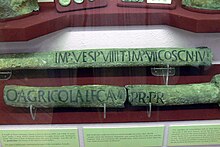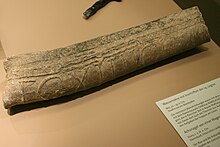Roman lead pipe inscription

A Roman lead pipe inscription is a Latin inscription on Roman aqueducts from lead ( lat. Fistula aquaria ) that provide information on their manufacturers and owners, often the emperor himself as a top client. The concise lettering was created with full-text stamps, the use of movable letters has not been proven despite other hypotheses.
Manufacture of lead pipes
Lead, which appeared in large quantities as a by-product of ancient silver smelting , was extracted on an industrial scale during the Roman Empire, with an estimated peak production of 80,000 tons per year. The metal was used among other materials for the manufacture of water pipes in the extensive water supply network of the Romans; it was used almost exclusively in inner-city areas in particular.
The way in which the lead pipes were made has been handed down from Vitruvius and Frontinus . The lead was first poured into panels, which were then bent around a log and soldered at the seam. The cross-section of the approx. 3 meter long pieces of lead pipe was dependent on the water flow rate and could range from approximately 1.3 cm to 57 cm in diameter.
Making the inscriptions
Since the 19th century, the hypothesis has often been put forward that the inscriptions were made by the Romans with movable letters. A typographical investigation by the typesetter and linguist Herbert Brekle recently supports the widespread assumption that all of these must have been multi-word stamps: "All in all, material evidence, practical and economic consequences and the available data speak clearly in favor of the full-text stamps. Hypothesis. "The current production method was therefore:
“A stamp ( patrix ) with the text engraved in the right way as a high relief is pressed into the slightly damp, pressed sand or clay surface of the mold and results in a reverse imprint of the text ( matrix ) as a deep relief . After pouring liquid lead, the inscription appears in high relief on the surface of the lead pipe. Today this is the most plausible hypothesis for the production of such inscriptions ( full text stamp ). "
According to Brekle, the following reasons speak for the use of stamps and against the typographic technique: From a technical point of view, a single stamp block is much easier to handle with the Roman printing method than a package of individual letters , which in itself would be quite unstable and for the necessary internal cohesion Bracket or similar construction would have been required. Such a device is just as undetectable in the print image as the fine border lines between the individual letters that are typical for printing with movable letters. In contrast, the border to be found in text stamps, which is created by the impression of the surrounding edges of the stamp block, clearly stands out in at least one example.
In addition, according to Brekle, the lead pipe inscriptions that have survived never show any skewing or skewing of individual letters or their deviation from the baseline of the lines, as can happen with the typographical production method if the letters are not positioned correctly. Where the print image has slipped, the entire text train is affected, which clearly indicates the use of full text stamps. Last but not least, it must be borne in mind that an ancient character set with individual letters has never been found in archaeological excavations, but molds with inverted inscriptions that functioned like stamps.
See also
literature
- Herbert E. Brekle : Manufacturing techniques for inscriptions on Roman water pipes made of lead. In: Thomas Hanneforth, Gisbert Fanselow (Ed.): Language and Logos. Studies in Theoretical and Computational Linguistics. (Festschrift for Peter Staudacher on his 70th Birthday) (= Studia grammatica. Vol. 72). Akademie Verlag, Berlin 2010, ISBN 978-3-05-004931-1 , pp. 419–437.
- Werner Eck : The fistulae aquariae of the city of Rome: On the influence of social status on administrative action. In: Atti dell Colloquio Internazionale AIEGL su Epigrafia e Ordine Senatorio. Roma, 14-20 maggio 1981. = Epigrafia e Ordine Senatorio (= Tituli. Vol. 4, ZDB -ID 778040-0 ). Volume 1. Edizioni di Storia e Letteratura, Rome 1982, pp. 197-225.
- Klaus Grewe : Planning and routing of Roman water pipes (= series of publications by the Frontinus Society. Supplement vol. 1). Chmielorz, Wiesbaden 1985, ISBN 3-87124-025-7 .
- A. Trevor Hodge: Roman Aqueducts & Water Supply. Duckworth, London 1992, ISBN 0-7156-2194-7 .
- Sungmin Hong, Jean-Pierre Candelone, Clair C. Patterson, Claude F. Boutron: Greenland Ice Evidence of Hemispheric Lead Pollution Two Millennia Ago by Greek and Roman Civilizations. In: Science . Vol. 265, No. 5180, 1994, pp. 1841-1843, doi : 10.1126 / science.265.5180.1841 .
- Rodolfo Lanciani : Topografia di Roma antica. I comentarii di Frontino intorno le acque e gli acquedotti. Silloge epigrafica aquaria (= Accademia Nazionale dei Lincei. Classe di Scienze Morali, Storiche e Filologiche. Memorie. Series 3, Vol. 4, Fasc. 2, ISSN 0391-8149 ). Salviucci, Rome 1880, pp. 215-616 (reprint. Edizioni Quasar, Rome 1975).
- Pietrantonio Pace: Gli acquedotti di Roma e il De Aquaeductu di Frontino. Con testo critico versione e commento. 2nd Edition. Art Studio S. Eligio, Rome 1986.
Web links
Individual evidence
- ↑ Brekle (2010), p. 433 f.
- ↑ Brekle (2010), pp. 419 f., 436
- ↑ Hong, Candelone, Patterson, Boutron (1994), p. 1841
- ↑ Grewe (1985), p. 59; Hodge (1992), p. 307
- ↑ Hodge (1992), p. 309
- ↑ Hodge (1992), pp. 309-314
- ↑ Hodge (1992), p. 297, plate 209
- ↑ Lanciani (1881), p. 416; Pace (1986), p. 78
- ↑ Brekle (2010), p. 436
- ↑ Brekle (2010), p. 419
- ↑ Brekle (2010), p. 420
- ↑ a b Brekle (2010), p. 431
- ↑ Brekle (2010), p. 435
- ↑ Brekle (2010), p. 431 f.
- ↑ Brekle (2010), p. 426

